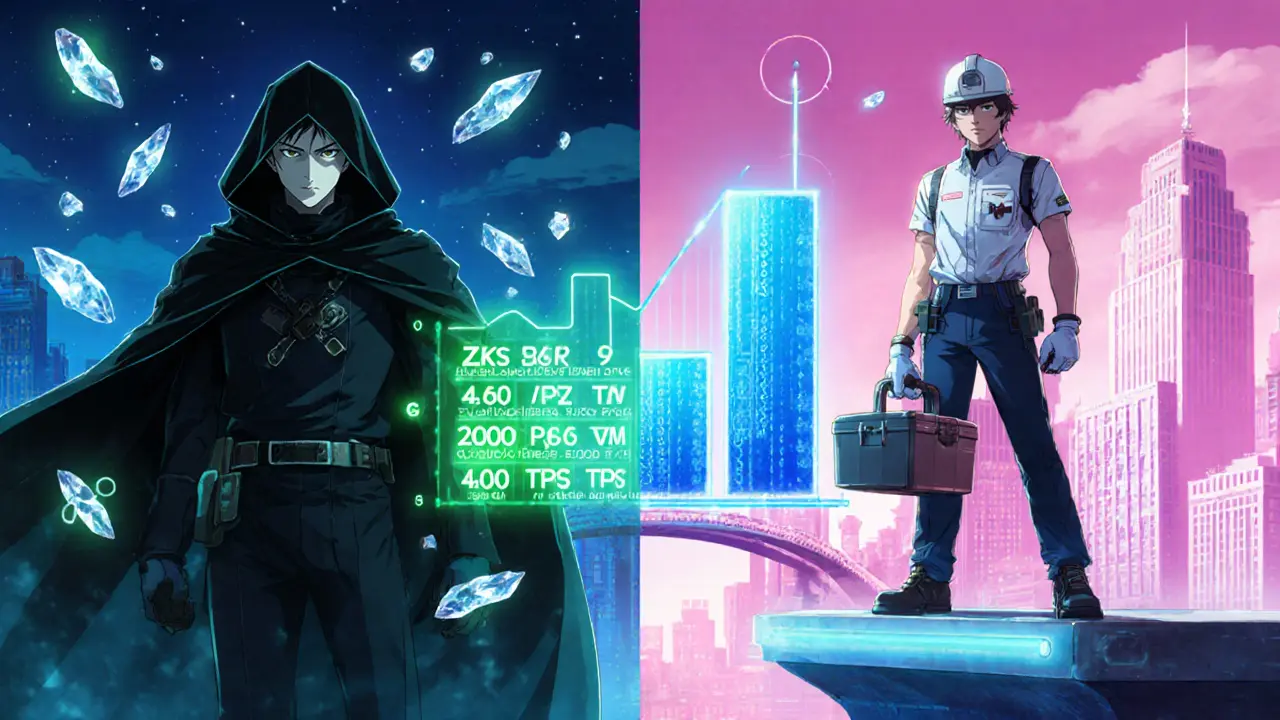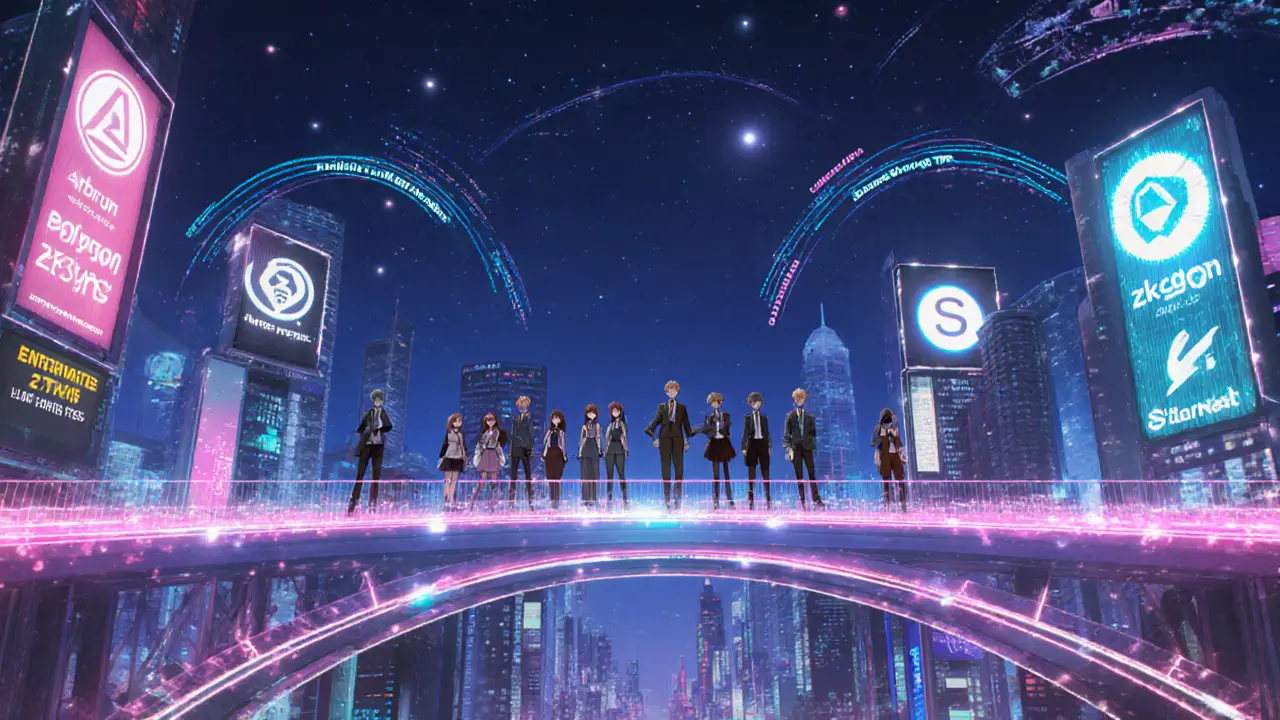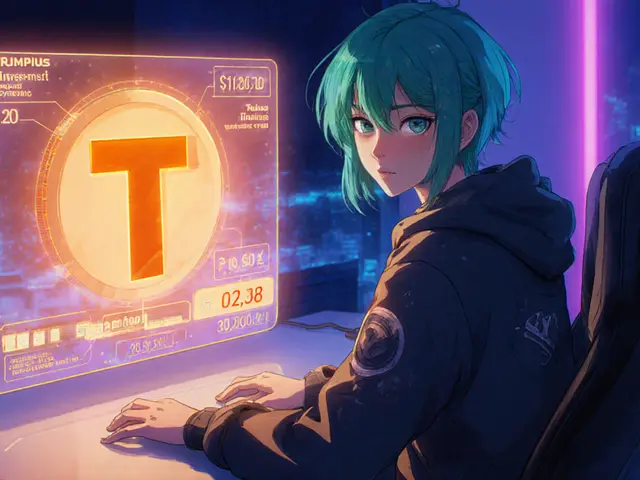Layer 2 Scaling Comparison Tool
Compare Layer 2 Solutions
Select two networks to compare their key metrics:
Key Takeaways
- Layer 2 solutions now push 4,000‑65,000TPS while slashing fees by up to 90%.
- ZK‑Rollups (StarkNet, zkSync) excel at privacy and proof‑size efficiency; Optimistic Rollups (Arbitrum, Optimism, Base) lead in EVM compatibility.
- Arbitrum holds the largest TVL, Polygon dominates raw throughput, and enterprise interest is shifting toward privacy‑focused ZK networks.
- Roadmaps target 40k‑plus TPS, seamless cross‑chain bridges, and frictionless onboarding for non‑technical users.
- Regulatory clarity is improving, but decentralization and bridge security remain the biggest risk vectors.
When you hear people talk about the Layer 2 scaling boom, they’re really describing a shift from “blockchain is slow and expensive” to “blockchain can handle millions of cheap transactions per second.” By September2025 the technology has moved beyond proof‑of‑concepts and is now the backbone of DeFi, NFT marketplaces, and even enterprise finance. This article walks through where the ecosystem stands today, which solutions lead the pack, and what you can expect in the next few years.
What Layer2 Scaling Actually Means
Layer 2 scaling is a set of protocols that sit on top of a base blockchain (most often Ethereum) and bundle many transactions into a single proof that the main chain can verify. The main chain still guarantees security, while the secondary layer handles the heavy lifting of moving funds and executing contracts.
Because the main chain only needs to store a succinct proof, transaction throughput skyrockets and gas fees collapse. Think of it as a highway overpass that relieves congestion on the main road without abandoning the original route’s safety standards.
Two Main Families: ZK‑Rollups vs Optimistic Rollups
Zero‑Knowledge Rollups (ZK‑Rollups) generate cryptographic proofs that *prove* a batch of transactions is valid without revealing the underlying data. Leading ZK‑Rollup nets like zkSync and StarkNet offer sub‑second finality and built‑in privacy-key for enterprises that can’t expose trade details.
Optimistic Rollups assume transactions are valid and only run a fraud proof if someone challenges them. This design gives developers near‑full EVM compatibility, making migration from Ethereum painless. The heavy hitters are Arbitrum, Optimism, and Coinbase’s Base.
Performance Snapshot (2025)
| Network | TPS | TVL (USD) | # dApps | Typical Fee |
|---|---|---|---|---|
| Arbitrum | 4,000 | $6.2B | 600+ | ≈$0.01 |
| Optimism | 4,000 | $3.5B | ≈300 | ≈$0.01 |
| Polygon | 65,000 | $2.1B | 1,000+ | ≈$0.005 |
| StarkNet | 20,000 | $1.2B | ≈150 | ≈$0.02 |
| zkSync | 15,000 | $800M | ≈100 | ≈$0.015 |

Adoption Patterns: Who Is Using What?
DeFi protocols favor Optimistic Rollups because they can port existing smart contracts unchanged. For example, users on Arbitrum report transaction costs in cents, turning previously prohibitive token swaps into everyday actions.
Enterprises that demand confidentiality-think supply‑chain finance or tokenized equity-are gravitating toward ZK‑Rollups. The zero‑knowledge proofs keep sensitive data hidden while still providing the same security guarantees as the Ethereum mainnet.
Gaming and NFT platforms need raw speed, so they often sit on Polygon. Its 65kTPS ceiling means every in‑game item transfer or NFT mint can happen instantly without the user fretting over gas.
What the Roadmap Looks Like (2025‑2027)
Recent client releases show several networks already hitting 40,000TPS in test environments, with production roll‑outs slated for early 2026. The next big wave is cross‑layer interoperability: a unified bridge protocol that lets users move assets between Arbitrum, Optimism, and ZK‑Rollups in a single transaction.
On the UX side, onboarding tools are shrinking from hours to minutes. Wallets now auto‑detect supported Layer2s, suggest the cheapest bridge route, and batch gas‑fee payments into a single “pay‑once” UI element.
Security audits are becoming mandatory for high‑value contracts. Projects like the Ethereum Foundation’s “Layer2 Audits Initiative” fund independent reviews, pushing the ecosystem toward a more trustworthy baseline.
Risks to Keep an Eye On
Regulators in some jurisdictions still view Layer2 activity as a gray area, especially when privacy‑preserving ZK proofs are involved. While the U.S. Federal Reserve has signaled openness, compliance frameworks are still forming.
Decentralization pressure is another challenge. As transaction volumes soar, the validator set could become more centralized if staking barriers aren’t lowered. Projects are experimenting with hybrid consensus models to keep the network open while preserving speed.
Finally, bridge exploits remain a headache. Even though newer bridge designs cut the number of required hops, a single smart‑contract bug can still lock up millions of dollars. Ongoing research in formal verification aims to iron out those vulnerabilities.
Getting Started: Users and Developers
For regular users, the quickest path is to add the desired network to a wallet like MetaMask, then use the built‑in “bridge” button to move ETH or stablecoins. The whole process typically takes 15‑30minutes for someone familiar with Ethereum.
Developers targeting Optimistic Rollups can copy‑paste their existing Solidity code, re‑compile with the same compiler version, and deploy to Arbitrum or Optimism with minimal changes. ZK‑Rollup devs need to adjust for zk‑EVM compatibility-often rewriting parts of the logic to fit into zk‑circuits-but the payoff is privacy and even lower fees.
Both ecosystems offer grant programs totaling over $50million in 2025, so new projects can apply for funding to cover audit costs and community building.
Conclusion: A New Architectural Layer Is Here to Stay
The data points-thousands of TPS, 90% fee reduction, billions in TVL-show that Layer2 scaling isn’t a temporary patch. It’s becoming the default interaction layer for most real‑world blockchain use cases. As cross‑chain bridges mature and regulatory frameworks clear up, you’ll see even more traditional finance and gaming companies hopping onto these networks.

Frequently Asked Questions
What is the main difference between ZK‑Rollups and Optimistic Rollups?
ZK‑Rollups generate a cryptographic proof that a batch is valid before it’s posted, giving instant finality and built‑in privacy. Optimistic Rollups assume transactions are correct and only run a fraud proof if someone challenges them, which makes them easier to integrate with existing Ethereum contracts.
Which Layer2 network has the highest transaction throughput?
Polygon leads the pack with a reported 65,000TPS capacity, making it ideal for high‑frequency trading apps and blockchain games.
How much can I expect to pay for a typical transaction on a Layer2?
Most Layer2s charge fees measured in cents-roughly $0.005‑$0.02 per transaction-compared with $5‑$30 on Ethereum’s mainnet during peak congestion.
Do I need to trust the Layer2 operator?
Security ultimately relies on the Ethereum base chain. Even if a Layer2 operator misbehaves, the mainnet can reject invalid proofs, protecting user funds.
What’s the best way to start building on a Layer2?
Pick an Optimistic Rollup like Arbitrum for straight‑forward EVM compatibility, clone your existing Solidity contract, and deploy using the same tooling (Hardhat, Truffle). If you need privacy, start a small prototype on zkSync’s testnet to learn its zk‑EVM nuances.







Comments
MD Razu
October 1, 2025 AT 02:13 AMThe conversation about Ethereum's Layer 2 future inevitably drifts into the realm of metaphysics, where speed and cost become proxies for human ambition.
When we contemplate a network that can process tens of thousands of transactions per second, we are really pondering the limits of collective trust.
The architecture of ZK‑Rollups, with their cryptographic proofs, mirrors the Platonic idea of forms-ideal truths manifested without exposing the underlying particulars.
Conversely, Optimistic Rollups assume good faith, invoking a kind of social contract that only collapses under the weight of a fraud proof.
This duality reflects the ancient dialectic of optimism versus skepticism, now encoded in bits and bytes.
Yet the practical implications are stark: lower fees democratize access, allowing actors without deep pockets to participate in decentralized finance.
The reduction from dollars to cents per transaction is not merely an engineering triumph but a socio‑economic equalizer.
Moreover, the burgeoning TVL on Arbitrum and the raw throughput of Polygon illustrate divergent pathways toward mass adoption.
One path emphasizes composability and EVM compatibility, the other pursues raw performance at the expense of some convenience.
As developers toggle between these trade‑offs, they are performing a kind of modern alchemy, transmuting code into value across strata.
The emergence of cross‑layer bridges introduces a new layer of complexity, akin to the great rivers that both connect and divide ancient civilizations.
Security audits, mandated by the Ethereum Foundation, act as the vigilant sentinels guarding against the chaos of unchecked growth.
Yet we must remain vigilant, for centralized validator sets could reconstitute the very hierarchies we sought to escape.
In this light, the push toward hybrid consensus models can be seen as a philosophical reconciliation of liberty and order.
The roadmap toward 40k‑plus TPS by 2026 is not a mere technical milestone; it is a testament to humanity's relentless pursuit of efficiency.
Ultimately, the future of Layer 2 scaling is less about numbers and more about the collective imagination that dares to reconfigure how we exchange value.
Charles Banks Jr.
October 3, 2025 AT 09:46 AMSo we finally got Layer 2s that can crank out 65k TPS, because apparently 4,000 was just “meh” for the early adopters.
Optimistic Rollups brag about EVM compatibility like it’s a badge for being the class clown of the blockchain world.
Meanwhile ZK‑Rollups sit on their throne of privacy, acting like they’ve solved the world’s problems while we’re still paying cents for gas.
At the end of the day, it’s just another layer of hype that makes us wonder if anyone actually reads the fine print.
Ben Dwyer
October 5, 2025 AT 17:19 PMIf you’re just starting, focus on the network that matches your app’s needs rather than chasing the highest TPS headline.
Polygon’s speed is great for gaming, while Arbitrum’s EVM compatibility smooths the migration path for DeFi projects.
Pick one, test on its testnet, and iterate-you’ll learn a lot more than by reading endless comparison tables.
Lindsay Miller
October 8, 2025 AT 00:53 AMIt’s understandable to feel overwhelmed by all the numbers and acronyms in the scaling space.
Remember that each solution is built to address a specific problem, so you can take it one step at a time.
Katrinka Scribner
October 10, 2025 AT 08:26 AMHey there! I love how zkSync is pushing privacy while still keeping fees low 😊.
The whole bridge thing can be kinda confusing but don’t worry, most wallets are getting smarter every day 😅.
Just pick a network you trust and jump in-you’ll be amazed at how smooth it feels.
VICKIE MALBRUE
October 12, 2025 AT 15:59 PMLayer2s are opening the door for everyday users to experience blockchain without the wallet‑draining fees.
Waynne Kilian
October 14, 2025 AT 23:33 PMI think we all can agree that the real power of L2s lies in their ability to bring people together across diffrent chains.
While Arbitrum and Optimism give us familiar tools, ZK‑Rollups whisper a promise of privacy that many ignore.
It would be great if the community could focus on building bridges that feel as natural as crossing a street.
Let’s keep the conversation friendly and keep pushing forward for a more inclusive ecosystem.
Naomi Snelling
October 17, 2025 AT 07:06 AMSome folks forget that every bridge is a potential backdoor for the powers that be to siphon off value.
The rush to adopt cross‑layer solutions feels like a coordinated push to hide activity from regulators.
We should be asking who profits when a new rollup promises “instant finality” while the underlying validators stay opaque.
Stay vigilant; the next exploit might come from a “secure” bridge you’ve just trusted.
Michael Wilkinson
October 19, 2025 AT 14:39 PMStop glossing over the fact that centralized validator sets threaten the very decentralization ethos we claim to protect.
If we don’t address this now, the whole L2 ecosystem will crumble under its own contradictions.
Billy Krzemien
October 21, 2025 AT 22:13 PMThe roadmap toward unified bridges is a critical step, and the recent audits demonstrate a commendable commitment to security.
Developers should take advantage of the grant programs to fund rigorous testing and formal verification.
By collaborating across rollup communities, we can ensure a resilient and interoperable future.
april harper
October 24, 2025 AT 05:46 AMIn the grand theater of blockchain hype, Layer 2s are the flashiest understudies that never quite steal the spotlight.
Clint Barnett
October 26, 2025 AT 13:19 PMPicture a bustling metropolis where every street is a separate chain, and the bridges are neon‑lit portals humming with encrypted traffic.
That’s essentially what the next wave of L2 interoperability aims to achieve, turning isolated silos into a vibrant, interconnected ecosystem.
The engineering challenges are immense, ranging from seamless state syncing to safeguarding against replay attacks.
Yet the community’s creative energy is palpable, with hackathons spawning novel bridge prototypes faster than ever.
Developers are now wielding colorful libraries like Axelar and Wormhole to stitch together disparate rollups.
As these tools mature, user experience will shift from “technical gymnastics” to a simple click‑and‑go flow.
We should celebrate the incremental victories, even as we remain vigilant about security trade‑offs.
Ultimately, the vision of a frictionless, multi‑layered blockchain world feels both exhilarating and within reach.
Jacob Anderson
October 28, 2025 AT 20:53 PMOh great, another “Layer 2 boom”-because the blockchain world definitely needed more hype cycles.
Let’s hope the next set of rollups actually deliver on their promises instead of just adding another layer of complexity.
Kate Nicholls
October 31, 2025 AT 04:26 AMWhile the performance gains of ZK‑Rollups are impressive, their developer tooling is still catching up to the ease of Optimistic Rollups.
Conversely, Optimistic solutions benefit from mature ecosystems but suffer from delayed finality.
A pragmatic approach is to evaluate both on a case‑by‑case basis, aligning the choice with specific usability and security requirements.